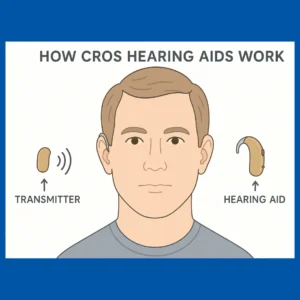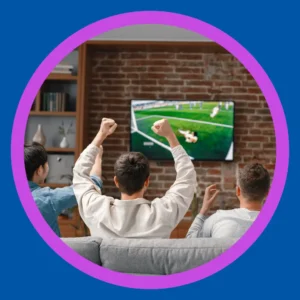Understand CROS Hearing Aids
If you struggle with hearing in one ear or uneven hearing between ears, a CROS hearing aid may help. These devices reroute sound to your better ear and restore balance to your hearing. They help thousands of Americans every day.
Let’s explore how these hearing aids work, who benefits, and how they support daily life.

What Is a CROS Hearing Aid?
CROS stands for Contralateral Routing of Signals. This hearing system supports people who have no usable hearing in one ear. The key idea is to ensure you don’t miss sounds from your weaker side.
With a CROS system:
- A transmitter goes on your non-hearing ear.
- A receiver and microphone sit on your better-hearing ear.
- Sounds from the poorer side transmit wirelessly to the better ear.
CROS hearing aids do not amplify sound in the non-hearing ear. Instead, they give you access to those sounds through the ear that works.
This creates a fuller sound environment and improves everyday communication.
Explore the features available in Phonak hearing devices.
Why CROS Hearing Aids Matter for SSD
Hearing in one ear presents unique problems, especially in noisy places. You may struggle to follow conversations, miss key sounds, or turn your head constantly.
One major challenge is the head shadow effect. Your head blocks high-frequency sounds from reaching your good ear. These sounds include consonants, which are vital for understanding speech.
CROS hearing aids overcome this by routing sound around the head. They let your better ear hear sounds from both sides, improving clarity and awareness.
What Is a BiCROS Hearing Aid?
BiCROS hearing aids support people with uneven or asymmetric hearing loss. They help when both ears have hearing loss—but one side is significantly worse.
BiCROS stands for Bilateral Routing of Signals. It combines sound routing with amplification.
Here’s how BiCROS works:
- The poorer ear wears a transmitter.
- The better ear wears a receiver with a hearing aid.
- The system both routes sound from the bad side and amplifies sound in the better ear.
BiCROS hearing aids benefit people who might hear some sounds on both sides but need different levels of help.
They are ideal for:
- People with moderate loss in one ear and severe loss in the other.
- People who cannot use traditional hearing aids in the worse ear.
- Individuals who need a balanced, customized solution for daily hearing.
Learn more about custom hearing aids.
Who Can Benefit From CROS or BiCROS Hearing Aids?
CROS aids support those with single-sided deafness (SSD). That means no usable hearing in one ear and normal or near-normal hearing in the other.
BiCROS aids help people with asymmetric hearing loss. That’s when hearing differs between ears, and the better ear also needs some help.
Causes include:
- Sudden hearing loss.
- Head injuries or trauma.
- Acoustic neuroma (benign nerve tumors).
- Ménière’s disease.
- Infections or inner ear damage.
- Age-related hearing decline.
If your hearing loss came on suddenly, consult an ENT immediately. Prompt treatment improves outcomes. If medical treatment isn’t possible, hearing care providers can help you find a fitting device.
Get answers to frequently asked questions about hearing loss.

Benefits of CROS and BiCROS Hearing Aids
These hearing systems won’t restore hearing in your weaker ear. But they can dramatically improve how you interact with sound.
Key Benefits:
- Improved speech understanding in noisy spaces like restaurants or meetings.
- Fuller awareness of your environment when walking or driving.
- Better balance in conversation without shifting or turning your head.
- Less listening fatigue, especially during long discussions.
By transmitting sound to your stronger ear, these devices reduce stress and enhance confidence.
Common Questions About CROS and BiCROS Devices
Do they improve hearing in the bad ear?
No. They send sound from that ear to the better ear.
Can I still tell where sound comes from?
Not always. Localization may still be difficult, but some users adapt with time.
Can I use the better ear’s device alone?
Yes. But you’ll miss out on sounds from your other side.
Can they be rechargeable?
Yes. Both battery-powered and rechargeable options are available.
Your hearing care provider will help you choose the best style and features.
Discover more about Bluetooth and noise canceling hearing aids.
Why Not Just Aid the Poorer Ear?
In some cases, amplifying the bad ear causes more problems than it solves.
Here’s why:
- Rollover loss: Speech clarity gets worse at higher volumes.
- Dead regions: Parts of the cochlea may not respond to sound at all.
- Recruitment: Loud sounds feel painfully loud very quickly.
- Distortion: High gain causes unnatural or fuzzy sound quality.
- Cross-hearing: Amplified sound can leak into the good ear, creating confusion.
CROS and BiCROS help avoid these problems while preserving clarity.
Alternatives to CROS and BiCROS Systems
Other solutions exist, but they may be more invasive or less effective.
Options include:
- Bone-anchored hearing devices: Surgically implanted; helpful if ear molds aren’t tolerated.
- Cochlear implants: Used in specific cases of profound hearing loss.
- Communication strategies: Positioning and lip reading may help in mild cases.
Your hearing care provider can help you compare all options. CROS and BiCROS offer powerful benefits without surgery.

Real-World Success With CROS and BiCROS Aids
CROS and BiCROS users often report improved confidence and comfort. These systems shine in everyday settings:
- Driving: Hear the driver from the passenger seat.
- Group meals: Follow conversations from any direction.
- Outdoor walks: Hear your walking partner without switching sides.
- Work settings: Engage in meetings more easily.
By restoring balance, these aids help people stay present and connected.
Better Hearing Starts With Balance
CROS and BiCROS hearing aids help people reclaim their hearing experience. Whether you face single-sided deafness or uneven hearing, these tools can make a huge difference.
You don’t have to settle for missing half the conversation.
Contact Stanford Hearing Today
Let our experienced hearing care providers guide you to the right solution. We offer personalized care, expert fittings, and advanced hearing technology.
Let’s find the right path to better hearing—on both sides.
